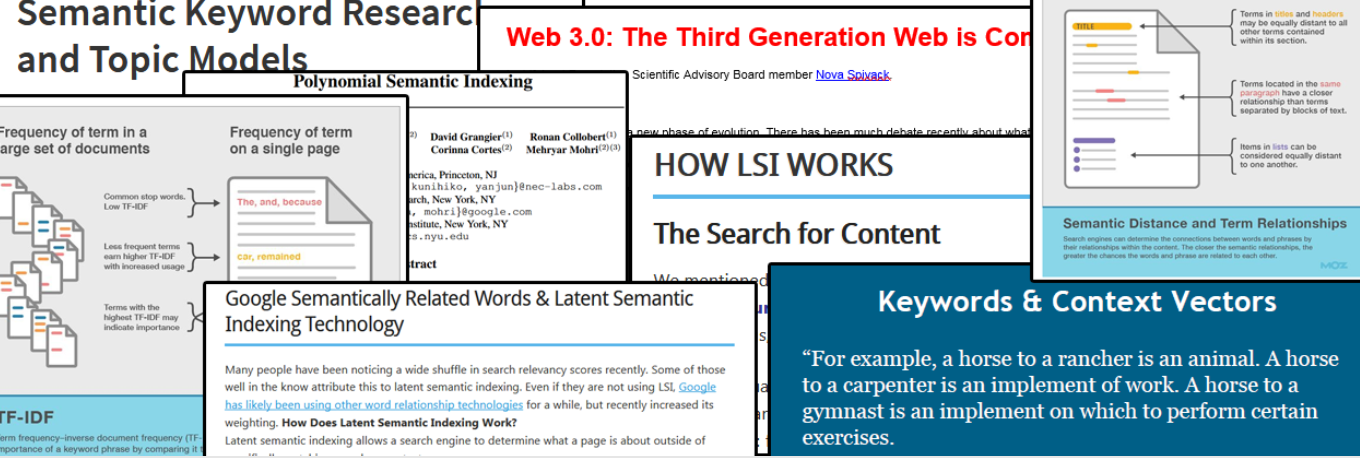 About Keywords:
About Keywords:
The idea of “keywords” has been driven out to marketers for the last partial decade, giving the impression that keywords are enough to get by these days. This (while still a portion of the big picture) is quickly becoming……not enough
Google wants the content to contain “words and phrases” that meet their criteria (which happens to contain words that are “key” to the topic of the content – aka: topical and theme-based)
in addition to other signals.
DIRECTLY FROM GOOGLE – REF
Let’s look at their posted statements regarding the evolvement of their engine
“Organize the world’s information and make it universally accessible and useful.”
“Strive to Deliver Useful and Relevant Results”
“Constantly evolving Search to improve your results.”
“From innovations like the Knowledge Graph to updates to our ranking algorithms that ensure we’re continuing to highlight relevant and authoritative content, our goal is always to improve the usefulness of your results”
Takeaway: Google is evolving (constantly), wants to serve (and own – see links) information to the world, and as a result, is constantly changing its engine to better serve relevant and useful results. Google is more interested than ever in providing the ultimate resource on something, in response to a search query.
(references: Google, Forbes, Motley Fool, USAtoday )
Also see at end of this piece:
Google’s movement towards extracting content and serving it vs. sending users to the actual web sites.
SEO FOR WRITERS – 2018+
(My top 5 recommended areas of concentration)
(present-to-future recommendations)
1- “Best of” and/or “phenomenal” content (Example articles listed below)
– creates authority (aka – why is our article better than say Apple’s, Microsoft’s article?)
– promotes “brand” (when applicable) – brand (entity and equity) passes authority to article
– engages, educates, informs, appeals, appeals directly to “queries”, in-depth, comprehensive
– drives conversions (if applicable) – (aka content engages and then passes user to next level/page)
– contains keywords (which can be better identified as your “core terms” plus relevant qualifiers)
– Robust over thin (see #4 – engagement = stronger user signals)
Solution: Study my examples (end of article)
This will give you a visual framework as to what articles are ranking better than others.
________________________
2- Content – Answers questions
– Comparable to item #1, but also constructed in phrasing so that Google can quickly identify answers to queries entered into search (Google robots – grab content snippets and feed answers back to users) – qualifying your content as authoritative.
Solution: Rather than keywords themselves, we are looking into queries, questions, and content that users are seeking on ours site/s. This collective is then passed onto the material (page content and context) itself.
________________________
3- Consolidate information, pages, and theme to 1 stronger page rather than 5+ thin pages (Topical, theme-centric subject matter)
– consolidates themes / topics to a central point of engagement (no more multi-page initiatives – aka “bait pages” based on versions of keyword phrases)
Solution: Your suggested work around here is to compliment the main landing page with relative articles (blog posts) of interest and same topical base. You want your prime landing page/s to carry theme, while using relative pages to compliment the page. The final action to this formula is to implement well placed, selective internal links from those pages to the prime page.
________________________
4- User signals: now a big part of Search Ranking
The extent of the content you create, better appeals to Google’s own stated user signals
What are they? (dwell time, bounce rate, pogo-sticking, user engagement time, CTR)
RankBrain (Google’s own technology) measures how users interact with the search results……and ranks them accordingly. Google has gotten much smarter at watching user behavior on sites and pages.
Solution: a few key immediate takeaways
– Robust content = potential for longer engagement
(comprehensive content designed to keep users on longer)
(note: another technique here is to use rich media, video embeds, charts…etc. to engage)
– Interesting content = less pogo-ticking or (bouncing off site/pages to another)
(content covers subject thoroughly, designed to keep user on site)
– User query satisfaction (back to point #2) – user satisfied with answer = moves forward rather than back to search for answer (vs negative relevancy signals)
– Content flow (content propels user to check out more content on site) = higher engagement rate for site itself
Please see example section below, for online examples
________________________
5- Word / Phrasing / Sentence relationship Patterns (algorithms)
This is 1 area that requires more research to establish a foundational matrix of the patterns and rules.
(A more mathematical / engineered way that search engines dissect content to arrive at signals (and proximities) that meet the criteria of their machine learning initiatives.)
I have been researching this, though it will take a bit longer to clarify the patterns…… and present it in a simpler way (coming this year….)
If you feel intrigued to examine for yourself, these initiatives can be found under the subjects:
TF-IDF, LSI (Latent Semantic Indexing), Semantic Search, (LDA) Latent Dirichlet Allocation, Entity Search, Entity Salience, Synonyms and close variants
Examples?
Usually (in most cases) you’ll find live examples of content that is ranking above others. This is the ultimate reveal.
These ranking materials should be analyzed for format, formula, and content structure as your prime takeaway.
Query: “Edge Server”
What you will notice right away is that each meets the criteria for SEO recommendations 1-3
(http://skype4businessinsider.com/reference/edge-server-fits-skype-business/)
robust, answers questions, branding, engages, has a conversion area (signup…etc), consolidates data, alot of relative terminology (keywords), internal links, rich media, graphics…..
another good example
https://www.cloudflare.com/learning/cdn/glossary/edge-server/
For further ideas: This page is a good one that provides links to other pages considered “best of” or 10X content
https://sparktoro.com/blog/resources/10x-content-by-rand-fishkin/
This new (potential) Google direction is of particular concern:
https://www.searchenginejournal.com/google-article-algorithm/253565/
(Ability to extract portions of a web site/s content and deliver out to users without sending them to the actual web pages
( before clicked on)
“We show that generating English Wikipedia articles can be approached as a multi-document
summarization of source documents.” REF
Thank you – I hope this helps in your efforts to stay progressive in SEO for content
Michael
Sources: (multiple articles spanning the last few years suggesting where content should be headed)
(This includes: Google’s own research white papers, Search engine land, moz, semrush, Bruce Clay, seo hacker, seo by the sea, ahrefs, backlinko, search engine journal, se roundtable…etc)
